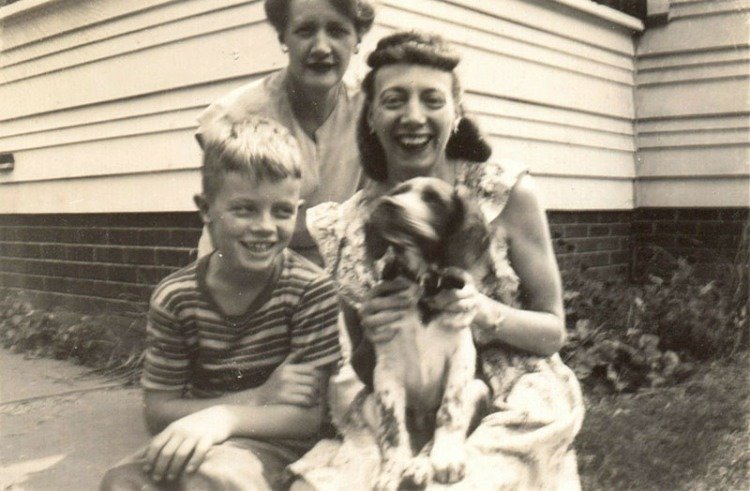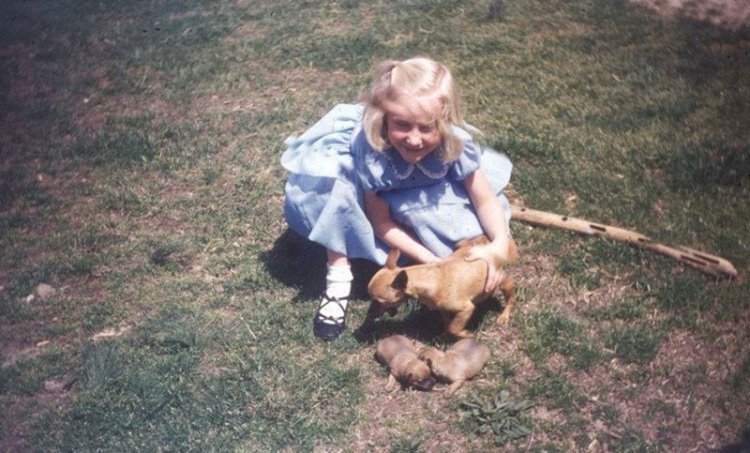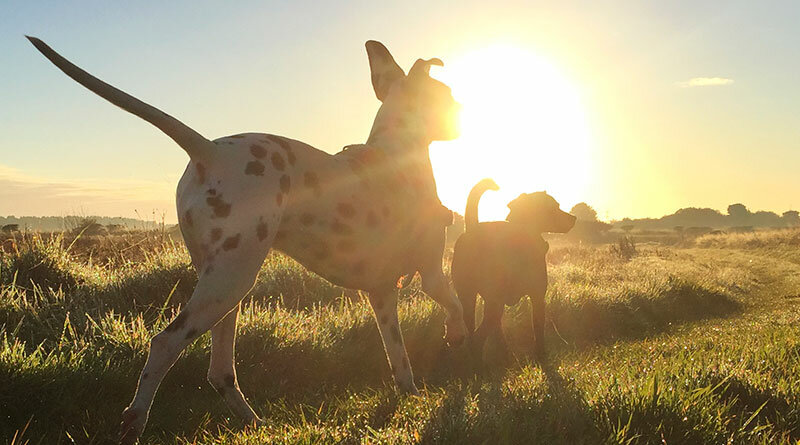Near Death Experiences: Will Our Dogs be Waiting For us?
As I raised my head up from the ground to look around, I saw my deceased dog from my childhood bounding towards me. … It was overwhelmingly wonderful. I felt completely at peace and totally happy. I was so excited to see her again, and I did not question the experience at the time. It was as if she had never died and she had always been waiting for me to wake up from my nap in the grass.
These words, taken from case reports collected by the Near-Death Experience Research Foundation, are from a young seaman who was recalling an experience that followed a life-threatening fall from a navy pier. After losing consciousness, he found himself in “an absolutely beautiful green field of grass” with his beloved canine friend.
After the reunion, he suddenly became aware that he was in the medical unit, and a corpsman was shouting at him to “wake up.” The seaman later described those moments with his dog as “very brief, but very real. …There was not a single aspect of that experience which did not feel real.”
The sensation of being transported from a life-threatening situation to a place of peace, meeting with a deceased being embodying love and connection, then finding oneself suddenly “sent back” is consistent with what are called near-death experiences (NDEs). The term was coined by Raymond Moody, MD, PhD, in his 1975 book, Life After Life, in which he identified some of the core aspects of these mysterious experiences.
GET THE BARK IN YOUR INBOX!
Sign up for our newsletter and stay in the know.
Subsequent research has revealed that NDEs are common when a person has a close brush with death, during a psychologically traumatic event or nears the end of life. Known to have occurred during cardiac arrests, traumatic injuries, surgery, accidents, suicide attempts, childbirth, combat, and life-threatening illnesses, NDEs are reported across many cultures and have been recorded throughout history.
Research suggests that around 20 percent of people who have a close call with death report one or more features of an NDE. These include a sense of leaving one’s body, being transported to a distant place (sometimes through a tunnel, which is where the “tunnel of light” imagery comes from), reuniting with deceased loved ones, meeting spiritual beings or experiencing a “panoramic” life review (sometimes spoken of as having one’s life pass before one’s eyes), then returning to the body.
Although these experiences can be distressing, they are usually associated with positive effects, such as an expanded understanding of spiritual matters, feelings of peace and joy, loss of fear of death, and a sense of interconnection with others,
Despite decades of empirical research exploring everything from the origins, prevalence and characteristics of NDEs to their impact and cross-cultural validity, no systematic research exists on the frequency with which the loved ones who appear during NDEs have four legs and a tail.
According to Janice Holden, EdD, LPC-S, LMFT, editor of the Journal of Near-Death Studies and lead editor of The Handbook of Near-Death Experiences, “Despite numerous people’s reports that they were reunited with beloved deceased pets during their NDEs, I’m not aware of a systematic study focused on this touching phenomenon.”*
Indeed, there are many tantalizing anecdotes and case reports of dogs coming to greet their human friends. For example, I worked with a patient named Alma, who, as she approached death, expressed a deep sense of peace. When I asked where this peace came from, she told me a story about having survived a fire many years earlier, during which she had lost consciousness and been burned severely.
I remember leaving my body. I could see myself on the ground below and the ambulance guys working on me. It was all very strange. Then I felt myself moving away. I saw a beautiful light and heard this amazing music that just brought me such peace. Eventually I found myself in a big yard where I’d grown up. I saw Sadie, my best childhood friend, a cute little Schnauzer. She was running toward me, wagging her tail. I’d missed her so much when she died. Yet, there she was, coming to greet me.
After an emotional reunion, Alma’s mother joined them and encouraged her to “go back.” Alma didn’t want to return. “I felt so happy, so loved. I wanted to be there forever.” As her mother spoke words of encouragement, Sadie licked Alma’s face. “She was licking me like crazy and I was laughing with joy. Then I suddenly woke up in the burn unit with the worst pain I’d ever felt.” Over the following months, as she endured many agonizing treatments, including several large skin grafts, Alma clung to those moments with her mother and Sadie. “I was never afraid of death again. I know I’m going to be okay. I know Sadie and Mom are waiting for me.”

End of Life Dreams and Visions
Many people have heard of NDEs but are surprised to learn that these experiences are part of a larger continuum of non-ordinary experiences common at the end of life. Often referred to as deathbed phenomena or end-of-life transpersonal experiences, these include things like end-of-life dreams and visions (ELDVs) and after-death communications.
End-of-life dreams refer to profound and meaningful dreams that occur within the context of dying—dreams that stand apart from others in that they are poignantly vivid and “more real than real.” For some, they have the quality of a waking experience more than a dream. Such dreams often bring a sense of connection with deceased loved ones and/or a felt sense of an afterlife as well as comfort, joy and an increased acceptance of death.
Maggie Callanan, a hospice nurse, chronicled her experiences with end-of-life dreams in her pioneering book with Patricia Kelley, Final Gifts. Hospice physician Christopher Kerr, MD, PhD, recently conducted systematic research into ELDVs. In his book, Death Is But a Dream: Finding Hope and Meaning at the End of Life, he observes that, although they can be transformative, their content “often consist[s] simply of dreams or visions about everyday events, family, love, even pets.”
Though dogs may appear in end-of-life dreams at any age, Kerr notes that they are especially likely to arrive in the dreams of dying children. Speculating on why, he writes, “Children often do not know someone who has already died. As a result, the deceased who have loved them best and come back to them in the end are often beloved pets.”
He recalls a 13-year-old named Jessica who was having dreams about her deceased black Lab. “I dream of my old dog, Shadow, that passed away. He is in a good place,” she said. “He occasionally comes to see me, and I have a feeling he is there to say it is okay. I’m in a safe place.”
Jessica’s dreams of Shadow occurred just prior to her death. According to Kerr, they brought the child “solace and the comfort of knowing she would be entering a sheltering, safe, and familiar territory alongside her furry friend.”
End-of-life visions, sometimes called deathbed visions, are similar to end-of-life dreams, but they occur when a patient is awake. Such visions are often experienced by patients as visitations or reunions with deceased loved ones whom only they can see. As with end-of-life dreams, these experiences are typically meaningful, comforting and profound. Many of those who experience these visions report that the “visitors” who arrive convey a sense that they will be accompanying the patient on a trip to another place. And, as with dreams, these visions sometimes include dogs.
Marilyn Mendoza, PhD, a clinical instructor at Tulane University Medical Center, recalls a dying woman who had a vision of her husband and dog, both of whom were deceased. “She stated that her husband had taken her hand and, along with the old dog, told her he would show her the path to follow to be able to die peacefully.”
Although such visions may occur months prior to death, they are most likely to occur when death is imminent. In their book, At the Hour of Death: A New Look at the Evidence for Life After Death, Karlis Osis, PhD, and Erlendur Haraldsson, PhD, estimate that about 62 percent of the patients in their study who’d had such visions died within 24 hours.
Given that these visions tend to occur so close to death when patients may no longer be able to communicate, the presence of some visions may only be inferred. For example, I once sat with a young man at the bedside of his dying mother. She hadn’t been awake in two days. Her respirations were shallow and rapid. Suddenly, she opened her eyes wide, a look of happiness and surprise on her face. “Come here, boy” she said excitedly, “I’ve missed you so much.” Then she closed her eyes and was silent, a smile still on her face.
I looked at her son to see what he made of what we had seen. He wiped tears from his eyes. “That’s exactly how she used to call our old dog, Trapper. She always had a special connection with him. Do you think it’s possible she saw him?”
Though impossible to confirm, I smiled and nodded my head.

After-Death Communication
After-death communication (ADC) involves seeing, sensing or receiving signs from a loved one who has died. In their book, The Art of Dying: A Journey to Elsewhere, neuropsychiatrist Peter Fenwick, MD, and his wife, Elizabeth Fenwick, estimate that between 20 percent to 50 percent of grieving individuals report some type of ADC. In a systematic review of all research on ADC from the late 1800s to 2010, Jenny Streit-Horn found that at least one in three people worldwide have reported ADC at some time in their lives—usually, but not always, in the context of grief.
Little is known about how frequently beloved dogs make such appearances after they die. According to Michael Fox, DVM, who has collected many such reports, it is common. Visits come in many forms, including seeing a dog’s form, hearing paws or barks, or inexplicably finding what looks like a deceased dog’s fur on a carpet that has recently been cleaned.
In his book, Dog Body, Dog Mind: Exploring Canine Consciousness and Total Well-Being, Fox shares a story about Anita, whose deceased dog Barney used to bump her side with his nose whenever he wanted to go outside. Shortly after Barney’s death, Anita began being awakened at night by the feeling of a little nose bumping up against her side. “One night when I awoke to turn over in bed,” Anita reported, “I saw his reflection in a mirrored closet door. I was surprised, but so glad that he was there. Looking closer at the floor in front of the mirror where he should be, he wasn’t there. He could only be seen in the mirror.”
As a long-time hospice social worker, I’ve heard many reports like these, involving human and animal loved ones. From dream visitations to unlikely coincidences and telling synchronicities, these experiences are often reassuring and meaningful. As Fox puts it, “Many people have been profoundly moved and comforted by the afterlife communications of their animal companions, and their lives have been significantly changed by the revelation that there is more to mortal life than we know.”
Despite the fact that these transpersonal events tend to bring peace, joy and comfort, affirming the continuation of connections thought to have been severed by death, many people are reluctant to share them with others, fearing they will be dismissed or ridiculed. Unfortunately, this often does happen when they are shared with those who are unsupportive or believe they know better.
Some people insist on reducing these events to biological (e.g., decreased oxygen, delirium) or psychiatric effects (e.g., hallucinations, wishful thinking). Some attribute them to imagination or medication side effects. Others reject them on the basis of personal beliefs or world views with which such experiences appear to be at odds.
Although some research suggests the possibility that there may be some biological mechanism at work, none have ever been proven. Moreover, there is also research suggesting these events are real and that consciousness survives beyond death.

But getting lost in a debate about the origins of these experiences—which is not likely to be solved any time soon—misses the point. For those who have had them, these events tend to be profound and transformative. As Fenwick suggests, “Perhaps all we can logically do is to recognize first, their validity for the dying person, and second, their inestimable value both to them and to the families who grieve for them. If we are fortunate enough to witness or experience these events, we must acknowledge their spiritual significance, and never dismiss them as meaningless by-products of the dying process.”
For those who have felt and received love from a faithful animal companion and who have grieved for the loss of a canine loved one, it is no stretch to imagine that one day, they will be waiting for us, tails wagging, when we make our own transitions into the mystery of death.
*Holden, J. Personal communication, 7/21/2020




